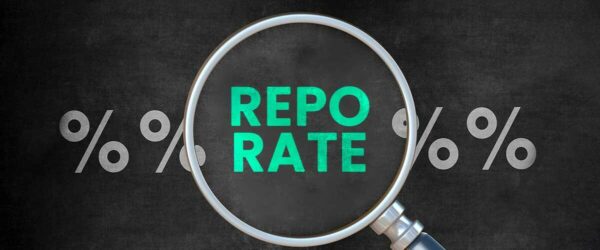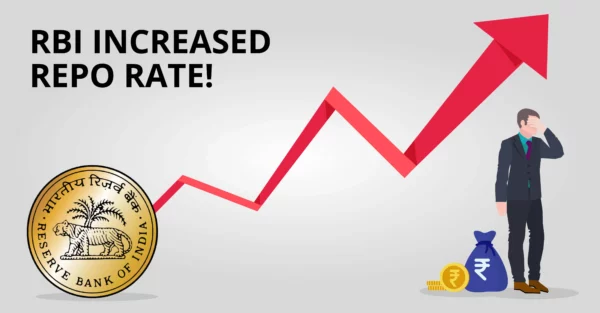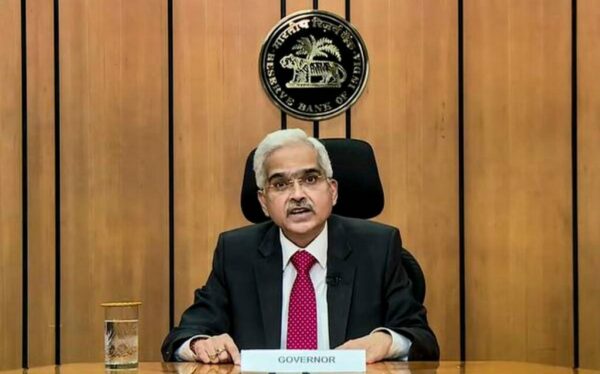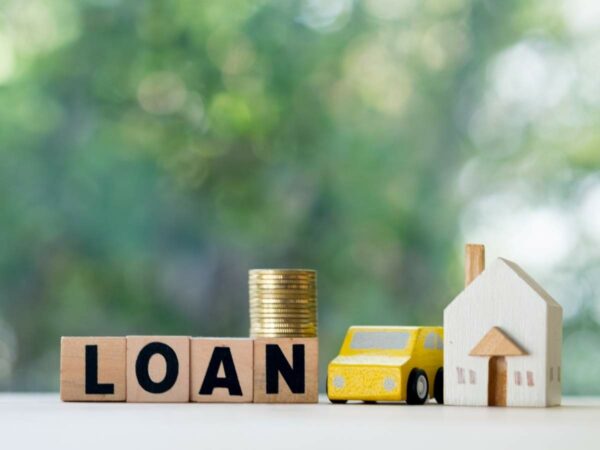How RBI’s Repo Rate Hikes Affect Consumers

How RBI’s Repo Rate Hikes Affect Consumers
The six-member Monetary Policy Committee (MPC) of the Reserve Bank of India (RBI) unanimously voted on Wednesday to raise the benchmark policy rate by 50 basis points, bringing the repo rate to 4.90 per cent, following a surprise rate hike in an off-cycle meeting in May.
As a result, the standing deposit facility (SDF) rate has been changed to 4.65 per cent, while the marginal standing facility (MSF) rate has been adjusted to 5.15, and the bank rate has been adjusted to 5.15 per cent. The MPC also unanimously agreed to keep focusing on removing accommodation to keep inflation in check while boosting growth in the future.
While the real GDP growth prognosis for FY23 has been kept at 7.2 per cent, with Q1 at 16.2 per cent, Q2 at 6.2 per cent, Q3 at 4.1 per cent, and Q4 at 4.0 per cent, the inflation forecast has been raised to 6.7 per cent, with Q1 at 7.5 per cent, Q2 at 7.4 per cent, Q3 at 6.2 per cent, and Q4 at 5.8 per cent. Throughout the first three-quarters of FY23, the MPC expects inflation to stay above the upper tolerance band of 6%.
“It should be emphasised that the food group accounts for almost 75% of the increase in inflation estimates. Furthermore, the RBI Governor Shaktikanta Das stated that the baseline inflation prediction of 6.7 per cent for 2022-23 “does not consider the impact of monetary policy decisions implemented today.”
Inflation climbed by around 170 basis points between February and April. With no end in sight to the war and inflation on the rise, smart monetary policy actions would ensure that the economy’s second-round consequences of supply-side shocks are limited, long-term inflation expectations are firmly anchored, and inflation progressively aligns closer to the target. Das stated that monetary policy initiatives, including the removal of accommodation, will be tailored to meet the needs of the ongoing economic recovery.
Further reductions in state VATs on petrol and gasoline across the country can surely contribute to the softening of inflationary pressures and expectations, he added, with household inflation expectations lowering following the excise duty cuts on petrol and diesel on May 21, 2022.
“Today’s 50-basis-point boost, on top of a 40-basis-point hike in May, reflects inflation pushing its way to the top of the RBI’s priority list, and the central bank belatedly attempting to catch up with the curve.” The RBI’s higher revision of the inflation prediction for FY23 to 6.7 per cent from 5.7 per cent in April was also in line with our expectations but still below our 7.2 per cent forecast. As a result, we feel we are still a long way from the finish line and that further frontloaded rate hikes are on the way,” said Aurodeep Nandi, vice president and India economist at Nomura.
The 10-year bond yield has declined 77 basis points to 7.46 per cent, as the rate hike was expected, and the Reserve Bank of India did not raise the cash reserve ratio (CRR).
“While further rate hikes are clearly on the table, the comment on the orderly completion of the government borrowing programme has worked to temper the 10-year G-sec yield, with reference to the revised repo rate of 4.9 per cent remaining below the pre-pandemic level. We expect further repo rises of 35 basis points and 25 basis points in the following two policies. However, the rise in yields will now be more gradual than we had anticipated,” said Aditi Nayar, ICRA’s chief economist.
Furthermore, systemic liquidity has slowed recently, in accordance with the emphasis on progressive withdrawal of accommodation indicated in the April and May MPC resolutions. Surplus liquidity was Rs 5.5 trillion from May 4-May 31, compared to Rs 7.4 trillion during April 8-May 3, 2022, as measured by average daily absorption under LAF – that is, absorption under SDF and variable rate reverse repo (VRRR) of 14 days and 28 days.
Nonetheless, according to Das, the surplus liquidity has resulted in overnight money market rates trading below the policy repo rate on average.
From now on, the Reserve Bank will ensure that appropriate liquidity is available to fulfil the economy’s productive needs while normalising the pandemic-related extraordinary liquidity accommodation over a multi-year time frame. He also stated that the Reserve Bank would remain focused on the government’s borrowing programme being completed in a timely manner.
What is the repo rate?
Before we go any further, let’s define a repo rate.
The term “buyback option” or “repurchase agreement” refers to the rate of a repurchase option or a repurchase agreement. SBI, ICICI Bank, HDFC Bank, and other commercial banks and financial institutions borrow money from the central bank at this rate.
Impact of Repo Rate on Economy
The repo rate is an important part of the country’s monetary policy and is used to control its liquidity, inflation, and money supply. Furthermore, repo rate levels have a direct impact on the borrowing patterns of banks.
In other words, when the repo rate is higher, banks must pay more interest to the RBI to obtain funds, and when the repo rate is lower, the cost of borrowing funds is lower.
The following scenarios look at how the repo rate affects the economy.
1. When the rate of inflation is high: When the economy is experiencing excessive inflation, the central bank (RBI) restricts the flow of money by raising the repo rate, resulting in fewer borrowings by firms and industries. As a result of this increase, the money supply and investment activity in the economy are reducing, which helps to keep inflation under control.
2. To increase the economy’s liquidity: When the market requires more liquidity, the RBI lowers the repo rate, allowing businesses to borrow money for investment reasons, increasing the economy’s money supply. As a result, such a step contributes to the economy’s growth.
The following are scenarios that could lead to a rise or fall in the repo rate:
Increase in Repo Rate
1. When there is a high inflation rate in the economy, and as per RBI, the condition may further surge.
2. When there is a risk of depreciation of the currency
3. When it wants to reduce any speculations that arise in areas of foreign exchange
4. The possibility of the formation of asset bubbles as a result of an excessive amount of capital formation
Decrease in Repo Rate
1. That situation in which RBI assumes that both inflation and the fiscal deficit are well controlled, and there is no unlikely possibility that a demand-led price surge will be observed.
2. When the economy is slowing down, RBI looks to accelerate the economy by facilitating a more friendly monetary policy.
3. If the balance of payments situation is deemed to be normal by the RBI.
Arising Inflation:
• During periods of high inflation, the RBI works hard to restrict the amount of money flowing through the economy. One way to achieve the goal is to increase the repo rate. As a result, borrowing costs rise for businesses and sectors.
• Borrowing becomes prohibitively expensive for businesses and industries, causing the economy’s investment and money supply to slow.
• As a result, it has a negative impact on economic growth, which aids in the management of inflation.
Escalated Liquidity in Market:
However, when the RBI has to inject cash into the system, it lowers the repo rate. As a result, businesses and industries can borrow money for diverse investment purposes at a lower cost. It also expands the economy’s total money supply. As a result, the economy’s growth rate improves.

Why is the repo rate increased?
The RBI raises the rate at which banks borrow money from the central bank if it expects inflation to exceed its tolerance limit.
Retail inflation has been over the Reserve Bank of India’s maximum tolerance limit of 6% for the past three months. Before the global pandemic in 2019, inflation was below 4% for the first time.
When the repo rate rises, the cost of borrowing for banks also increases, which is passed on to account holders in the form of higher loan and deposit interest rates.
Borrowing money from the bank becomes more expensive as a result, slowing investment and money supply in the market.
As a result, it restricts the money supply and lowers consumer spending power, which aids in inflation management.
When the government wants to inject money into the market to encourage economic growth, such as during the lockdown, the repo rate is lowered.
In fact, until last month, the RBI had not raised the repo rate in over four years.

How a small increase in repo rate affects you?
Borrowing from commercial banks becomes more expensive due to a slight increase in the repo rate. The rate hike impacts home loans, vehicle loans, education loans, personal loans, business loans, credit cards, and mortgages.
When borrowing costs rise, the average person is discouraged from making impulse purchases, lowering demand for products and services. This sets off a chain reaction, resulting in lower pricing and, as a result, lower inflation.
It’s just a game of supply and demand, with the repo rate serving as a trigger.
People who have savings or a fixed deposit, on the other hand, will gain from an increase in interest rates.
According to a survey by Stocktwits, banking stocks may profit from the increase in the repo rate.
Ripple effects of the hike in repo rate
When taking out a business loan becomes too expensive, businesses cut or stop employing, resulting in job losses.
Consumers are also delaying purchases of all luxury items, including automobiles, which impacts the car industry.
The real estate sector, which has seen a strong uptick in sales due to low financing costs, could be hurt by the RBI’s rate hike decision. As banks raise their interest rates, existing borrowers’ equivalent monthly instalments (EMIs) will rise, even more, putting potential homebuyers’ confidence in jeopardy.
Low-interest rates are unlikely to return, as the Indian government estimates that it will take at least 12 years for the country’s economy to recover from the effects of Covid-19. The ongoing structural changes triggered by the pandemic, according to the report, could alter the growth trajectory in the medium future.
Higher interest rates and inflation put the common man in a soup
The war in Ukraine has exacerbated the problems of ordinary people. Due to geopolitical tensions, commodities prices rose, affecting the global supply chain and tightening global financial conditions.
As a result of import restrictions and increased demand for basic commodities, everything from food and beverages to apparel and accessories is now quite expensive.
With limited purchasing power and a minimum wage, India’s common people were already struggling to meet their daily needs.
Consumers are losing buying power, which is a measure of how many products or services you can buy with a unit of money, at a faster-than-usual rate due to this increasing inflation.
While the current repo rate of 4.9 per cent is still lower than the pre-pandemic level of 5.15 per cent, increased consumer inflation would hurt the average person.
The Reserve Bank of India increased its inflation forecast for the current fiscal year to 6.7 per cent on Wednesday, up from 5.7 per cent in April and 4.5 per cent in February.
If inflation continues to rise despite recent adjustments in the repo rate, the RBI will raise it again in a few months to keep inflation under control.

RBI Repo Rate Hike! Lending rates to go up, borrowers to pay more for loan EMIs
When the repo rate is raised, banks’ funds’ cost rises. The repo rate is the rate at which banks borrow funds from the Reserve Bank of India. As a result, after the RBI raises the repo rate, the cost of borrowing for retail and other borrowers rises.
“Lending rates have already risen, as most loans are now tied to benchmarks such as the Repo rate or the MCLR. In the remaining MPC sessions in 2022, we should expect the RBI to keep raising rates. “By early 2023, we estimate the RBI to raise the repo rate to approach 6%,” says Pankaj Pathak, Fixed Income Fund Manager at Quantum AMC.
Many banks have already raised their lending rates for new and existing borrowers since the previous hike in May. Several non-bank financial institutions (NBFIs) and housing financing companies have also raised their lending rates.
The RBI repo rate hike immediately impacts retail loans, like home loans, that are tied to the bank’s external benchmark. Because most banks have tied their lending rates to the RBI repo rate, the impact on borrowers is immediate.
When the repo rate rises, so do the bank’s repo rate linked lending rate (RLLR). The borrower’s home loan interest rate will rise due to this. In actuality, instead of raising the EMI, banks usually lengthen the loan’s term.
MCLR loan borrowers, on the other hand, may not feel the impact of a repo rate hike right once. Even though the increase in the RBI repo rate raises the cost of financing for banks, they can only change the EMI or Tenure when the re-set date occurs. In MCLR-linked loans, the re-set date is usually 12 months, although, for a few institutions, it is even at 6-month intervals.
In general, the rate of interest on a flexible home loan will fluctuate. The only approach to lower your home loan EMI or interest payment is to keep replaying the outstanding loan amount whenever you have extra cash. The lower the cost of owning a property, the sooner you repay the loan.

Home loan burden to soar as RBI expected to raise repo rate yet again
A bank’s floating house loan interest rates must be linked to an external benchmark, which in most cases is the RBI repo rate. As a result, if the RBI repo rate is changed, it directly impacts a borrower’s EMI or term. Because the repo rate is transmitted instantly, the borrower sees the impact on his or her home loan interest rate within three months.
When the repo rate rises, so do the repo rate linked lending rate (RLLR), resulting in a rise in the borrower’s home loan interest rate. Banks, on the other hand, usually increase the loan’s duration rather than increasing the EMI.
The latest rate boost by the RBI was 0.4 per cent, and another 0.6 per cent increase will bring the repo rate to 1%, or 100 basis points. The entire 100 basis point rise will be reflected in the interest rate on house loans.
Assuming a loan outstanding of Rs 35 lakh, a 1 per cent increase in interest rate pushes the interest burden by almost 8 per cent (approximately Rs 3.6 lakh), keeping all other factors constant.
At 7.1 per cent ( on a Rs 35 lakh)
EMI – Rs 31,655
Interest paid – Rs 21,97,898
If the rate increases by 100 basis points or 1 per cent, then at 8.1 per cent (on a Rs 35 lakh)
EMI – Rs 33,650
Interest paid – Rs 25,57,000
The Reserve Bank of India (RBI) kept policy rates constant at its first meeting of the Monetary Policy Committee (MPC) for the financial year 2022-23 in April 2022. But then there was the unexpected rate hike of 0.4 per cent. The RBI is projected to raise the repo rate further in the future, affecting borrowing prices.
Here’s what the experts expect from RBI during the June 6-8, 2022 policy meeting.
Andromeda & Apnapaisa Executive Chairman V Swaminathan:
The RBI’s Monetary Policy Committee, chaired by the Governor, began its bi-monthly review this morning, looking at the impact of factors such as elevated inflation fears and changing geopolitical conditions on overpricing of various commodities.
The resolution is due on June 8, and it is a foregone conclusion that the benchmark lending rates will be raised once more.
Rate Hike Expectation: The RBI is expected to raise the repo rate from 4.40 per cent to 5.60 per cent before the conclusion of the current fiscal year.
Kotak Mahindra Asset Management’s Lakshmi Iyer is the Chief Investment Officer (Debt) and Head of Products.
The off-cycle rate hike has fueled speculation that the RBI may make rate hike decisions sooner rather than later. With the US still refusing to slow the speed and magnitude of rate hikes, and inflation showing no signs of abating, another rate hike appears to be a certain conclusion in the near future.
Rate Hike Expectation: In extrapolating the terminal repo rate for FY 2023, the magnitude of the rate hike (40-50 basis points, in our opinion) will be a crucial driver.
Kotak Mahindra Life Insurance’s Executive Vice President & Debt Investments, Churchil Bhatt
We may have reached the pinnacle of inflation for the time being, but we may not have seen its last. Failure to bring inflation down even after the central bank has reached the neutral rate could destabilise the economy. As a result, failing to confine the inflation genie should terrify markets more than policymakers’ efforts to do so.
Rate Hike Expectation: In June, the MPC is expected to make a no-brainer policy rate hike of 25-40 basis points (bps).
Shanti Ekambaram, Group President – Consumer Banking, Kotak Mahindra Bank
In view of increasing inflation, the MPC has signalled a gradual withdrawal of support. The RBI’s stance is anticipated to be “Neutral,” but it will remain committed to using all available tools to bring inflation closer to the target levels.
Rate Hike Expectation: In June’s policy, I foresee a rate hike of 35-50 basis points. Expect a total increase of 100 to 150 basis points in the repo rate from the current 4.40 per cent, based on inflation data and external factors such as oil and commodity prices.
Senior Economist at Kotak Mahindra Bank, Upasna Bhardwaj
We expect the MPC to revise the inflation trajectory upward by 70-80 basis points to account for the increasing price pressures. For the time being, the GDP figures may remain unaltered. Regarding policy withdrawal, the RBI has been fairly aggressive and quick in the recent two months. Since the April MPC policy, the weighted average overnight rates have climbed by 80-90 basis points.
Rate Hike Expectation: In the following June policy, we predict a repo rate hike of 35-40 basis points and no change in the CRR.




